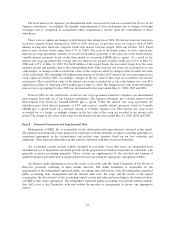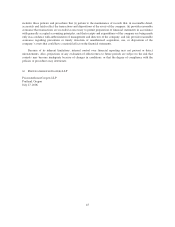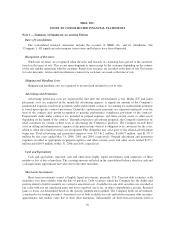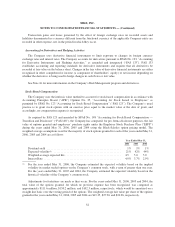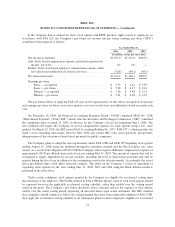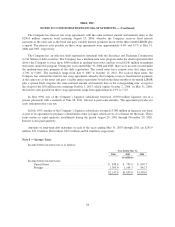Nike 2006 Annual Report Download - page 53
Download and view the complete annual report
Please find page 53 of the 2006 Nike annual report below. You can navigate through the pages in the report by either clicking on the pages listed below, or by using the keyword search tool below to find specific information within the annual report.
NIKE, INC.
NOTES TO CONSOLIDATED FINANCIAL STATEMENTS — (Continued)
Transaction gains and losses generated by the effect of foreign exchange rates on recorded assets and
liabilities denominated in a currency different from the functional currency of the applicable Company entity are
recorded in other expense, net, in the period in which they occur.
Accounting for Derivatives and Hedging Activities
The Company uses derivative financial instruments to limit exposure to changes in foreign currency
exchange rates and interest rates. The Company accounts for derivatives pursuant to SFAS No. 133, “Accounting
for Derivative Instruments and Hedging Activities,” as amended and interpreted (“FAS 133”). FAS 133
establishes accounting and reporting standards for derivative instruments and requires that all derivatives be
recorded at fair value on the balance sheet. Changes in the fair value of derivative financial instruments are either
recognized in other comprehensive income (a component of shareholders’ equity) or net income depending on
whether the derivative is being used to hedge changes in cash flows or fair value.
See Note 16 for more information on the Company’s Risk Management program and derivatives.
Stock-Based Compensation
The Company uses the intrinsic value method to account for stock-based compensation in accordance with
Accounting Principles Board (“APB”) Opinion No. 25, “Accounting for Stock Issued to Employees” as
permitted by SFAS No. 123 “Accounting for Stock-Based Compensation” (“FAS 123”). The Company’s usual
practice is to grant stock options with an exercise price equal to the market value at the date of grant, and
accordingly, no compensation expense is recognized.
As required by FAS 123 and amended by SFAS No. 148 “Accounting for Stock-Based Compensation —
Transition and Disclosure” (“FAS 148”), the Company has computed, for pro forma disclosure purposes, the fair
value of options granted and employees’ purchase rights under the Employee Stock Purchase Plan (“ESPP”)
during the years ended May 31, 2006, 2005 and 2004 using the Black-Scholes option pricing model. The
weighted average assumptions used for the majority of stock options granted for each of the years ended May 31,
2006, 2005 and 2004 are as follows:
Year Ended May 31,
2006 2005 2004
Dividend yield .................................................... 1% 1% 1%
Expected volatility(1) ............................................... 21% 42% 44%
Weighted-average expected life ....................................... 4.5 5.0 5.0
Interest Rate ...................................................... 4.0% 3.7% 2.9%
(1) For the year ended May 31, 2006, the Company estimated the expected volatility based on the implied
volatility in market traded options on the Company’s common stock, with a term of greater than one year.
For the years ended May 31, 2005 and 2004, the Company estimated the expected volatility based on the
historical volatility of the Company’s common stock.
Adjustments for forfeitures are made as they occur. For the years ended May 31, 2006, 2005 and 2004, the
total value of the options granted, for which no previous expense has been recognized, was computed as
approximately $111.6 million, $150.2 million, and $102.3 million, respectively, which would be amortized on a
straight line basis over the vesting period of the options. The weighted average fair value per share of the options
granted in the years ended May 31, 2006, 2005 and 2004 are $19.35, $27.90, and $20.36, respectively.
52


